Abstract
Accurate mass segmentation on mammograms is a critical step in computer-aided diagnosis (CAD) systems. It is also a challenging task since some of the mass lesions are embedded in normal tissues and possess poor contrast or ambiguous margins. Besides, the shapes and densities of masses in mammograms are various. In this paper, a hybrid method combining a random walks algorithm and Chan-Vese (CV) active contour is proposed for automatic mass segmentation on mammograms. The data set used in this study consists of 1095 mass regions of interest (ROIs). First, the original ROI is preprocessed to suppress noise and surrounding tissues. Based on the preprocessed ROI, a set of seed points is generated for initial random walks segmentation. Afterward, an initial contour of mass and two probability matrices are produced by the initial random walks segmentation. These two probability matrices are used to modify the energy function of the CV model for prevention of contour leaking. Lastly, the final segmentation result is derived by the modified CV model, during which the probability matrices are updated by inserting several rounds of random walks. The proposed method is tested and compared with other four methods. The segmentation results are evaluated based on four evaluation metrics. Experimental results indicate that the proposed method produces more accurate mass segmentation results than the other four methods.
Similar content being viewed by others
References
American Cancer Society, 2011. Cancer Facts & Figures 2011. Available from http://www.cancer.org/acs/groups/content/@epidemiologysurveilance/documents/document/acspc-029771.pdf
Ball, J.E., Bruce, L.M., 2007a. Digital Mammographic Computer Aided Diagnosis (CAD) Using Adaptive Level Set Segmentation. 29th Annual Int. Conf. of the IEEE Engineering in Medicine and Biology Society, p.4973–4978. [doi:10.1109/IEMBS.2007.4353457]
Ball, J.E., Bruce, L.M., 2007b. Digital Mammogram Spiculated Mass Detection and Spicule Segmentation Using Level Sets. 29th Annual Int. Conf. of the IEEE Engineering in Medicine and Biology Society, p.4979–4984. [doi:10.1109/IEMBS.2007.4353458]
Cao, Y., Hao, X., Xia, S., 2009. An improved region-growing algorithm for mammographic mass segmentation. SPIE, 7497:74971O-1–74971O-7.
Cao, Y., Hao, X., Zhu, X., Xia, S., 2011. Mammographic mass segmentation algorithm based on automatic random walks. J. Zhejiang Univ. (Eng. Sci.), 45(10):1753–1760 (in Chinese). [doi:10.3785/j.issn.1008-973X.2011.10.009]
Chan, T.F., Vese, L.A., 2001. Active contours without edges. IEEE Trans. Image Process., 10(2):266–277. [doi:10.1109/83.902291]
Chaudhury, K.N., Ramakrishnan, K.R., 2007. Stability and convergence of the level set method in computer vision. Pattern Recogn. Lett., 28(7):884–893. [doi:10.1016/j.patrec.2006.12.003]
Domínguez, A.R., Nandi, A.K., 2007. Improved dynamic-programming-based algorithms for segmentation of masses in mammograms. Med. Phys., 34(11):4256–4269. [doi:10.1118/1.2791034]
Grady, L., 2006. Random walks for image segmentation. IEEE Trans. Pattern Anal. Mach. Intell., 28(11):1768–1783. [doi:10.1109/TPAMI.2006.233]
Guliato, D., Rangayyan, R.M., Carnielli, W.A., Zuffo, J.A., Desautels, J.E.L., 1998. Segmentation of Breast Tumors in Mammograms by Fuzzy Region Growing. Proc. 20th Annual Int. Conf. of the IEEE Engineering in Medicine and Biology Society, p.1002–1005. [doi:10.1109/IEMBS.1998.745618]
Guliato, D., Rangayyan, R.M., Carnielli, W.A., Zuffo, J.A., Desautels, J.E.L., 2003. Segmentation of breast tumors in mammograms using fuzzy sets. J. Electron. Imag., 12(3): 369–378. [doi:10.1117/1.1579017]
Hao, X., Xia, S., 2009. A dynamic programming algorithm for mass segmentation on mammograms based on contour supervision. Sci. Technol. Rev., 27(21):56–60 (in Chinese).
Heath, M., Bowyer, K., Kopans, D., Kegelmeyer, W.P., Moore, R., Chang, K., MunishKumaran, S., 1998. Current Status of the Digital Database for Screening Mammography. Proc. 4th Int. Workshop on Digital Mammography, p.457–460.
Heath, M., Bowyer, K., Kopans, D., Moore, R., Kegelmeyer, W.P., 2000. The Digital Database for Screening Mammography. Proc. 5th Int. Workshop on Digital Mammography, p.212–218.
Hong, B.W., Sohn, B.S., 2010. Segmentation of regions of interest in mammograms in a topographic approach. IEEE Trans. Inf. Technol. Biomed., 14(1):129–139. [doi:10.1109/TITB.2009.2033269]
Kupinski, M.A., Giger, M.L., 1998. Automated seeded lesion segmentation on digital mammograms. IEEE Trans. Med. Imag., 17(4):510–517. [doi:10.1109/42.730396]
Oliver, A., Freixenet, J., Martí, J., Pérez, E., Pont, J., Denton, E.R.E., Zwiggelaar, R., 2010. A review of automatic mass detection and segmentation in mammographic images. Med. Image Anal., 14(2):87–110. [doi:10.1016/j.media.2009.12.005]
Osher, S., Sethian, J.A., 1988. Fronts propagating with curvature-dependent speed: algorithms based on Hamilton-Jacobi formulations. J. Comput. Phys., 79(1): 12–49. [doi:10.1016/0021-9991(88)90002-2]
Petrick, N., Chan, H.P., Sahiner, B., Helvie, M.A., 1999. Combined adaptive enhancement and region-growing segmentation of breast masses on digitized mammograms. Med. Phys., 26(8):1642–1654. [doi:10.1118/1.598658]
Qian, W., Li, L., Clark, L.P., 1999. Image feature extraction for mass detection in digital mammography: influence of wavelet analysis. Med. Phys., 26(3):402–408. [doi:10.1118/1.598531]
Sahiner, B., Petrick, N., Chan, H.P., Hadjiiski, L.M., Paramagul, C., Helvie, M.A., Gurcan, M.N., 2001. Computer-aided characterization of mammographic masses: accuracy of mass segmentation and its effects on characterization. IEEE Trans. Med. Imag., 20(12):1275–1284. [doi:10.1109/42.974922]
Song, E., Jiang, L., Jin, R., Zhang, L., Yuan, Y., Li, Q., 2009. Breast mass segmentation in mammography using plane fitting and dynamic programming. Acad. Radiol., 16(7): 826–835. [doi:10.1016/j.acra.2008.11.014]
Song, E., Xu, S., Xu, X., Zeng, J., Lan, Y., Zhang, S., Hung, C.C., 2010. Hybrid segmentation of mass in mammograms using template matching and dynamic programming. Acad. Radiol., 17(11):1414–1424. [doi:10.1016/j.acra.2010.07.008]
te Brake, G.M., Karssemeijer, N., 2001. Segmentation of suspicious densities in digital mammograms. Med. Phys., 28(2):259–266. [doi:10.1118/1.1339884]
Timp, S., Karssemeijer, N., 2004. A new 2D segmentation method based on dynamic programming applied to computer aided detection in mammography. Med. Phys., 31(5):958–971. [doi:10.1118/1.1688039]
Wang, Y., Tao, D., Gao, X., Li, X., Wang, B., 2011. Mammographic mass segmentation: embedding multiple features in vector-valued level set in ambiguous regions. Pattern Recogn., 44(9):1903–1915. [doi:10.1016/j.patcog.2010.08.002]
Xiao, M., Xia, S., Wang, S., 2005. Geometric Active Contour Model with Color and Intensity Priors for Medical Image Segmentation. 27th Annual Int. Conf. of the Engineering in Medicine and Biology Society, p.6496–6499. [doi:10.1109/IEMBS.2005.1615987]
Xu, S., Liu, H., Song, E., 2011. Marker-controlled watershed for lesion segmentation in mammograms. J. Dig. Imag., 24(5):754–763. [doi:10.1007/s10278-011-9365-2]
Xu, W., Xia, S., Duan, H., Xiao, M., 2006. Segmentation of mass in mammograms using a novel intelligent algorithm. Int. J. Pattern Recogn. Artif. Intell., 20(2):255–270. [doi:10.1142/S0218001406004648]
Yuan, Y., Giger, M.L., Li, H., Suzuki, K., Sennett, C., 2007. A dual-stage method for lesion segmentation on digital mammograms. Med. Phys., 34(11):4180–4193. [doi:10.1118/1.2790837]
Zhang, Y., Tomuro, N., Furst, J., Stan Raicu, D., 2010. Image enhancement and edge-based mass segmentation in mammogram. SPIE, 7623:76234P-1–76234P-8.
Author information
Authors and Affiliations
Corresponding author
Additional information
Project (Nos. 60772092 and 81101903) supported by the National Natural Science Foundation of China
Rights and permissions
About this article
Cite this article
Hao, X., Shen, Y. & Xia, Sr. Automatic mass segmentation on mammograms combining random walks and active contour. J. Zhejiang Univ. - Sci. C 13, 635–648 (2012). https://doi.org/10.1631/jzus.C1200052
Received:
Accepted:
Published:
Issue Date:
DOI: https://doi.org/10.1631/jzus.C1200052




